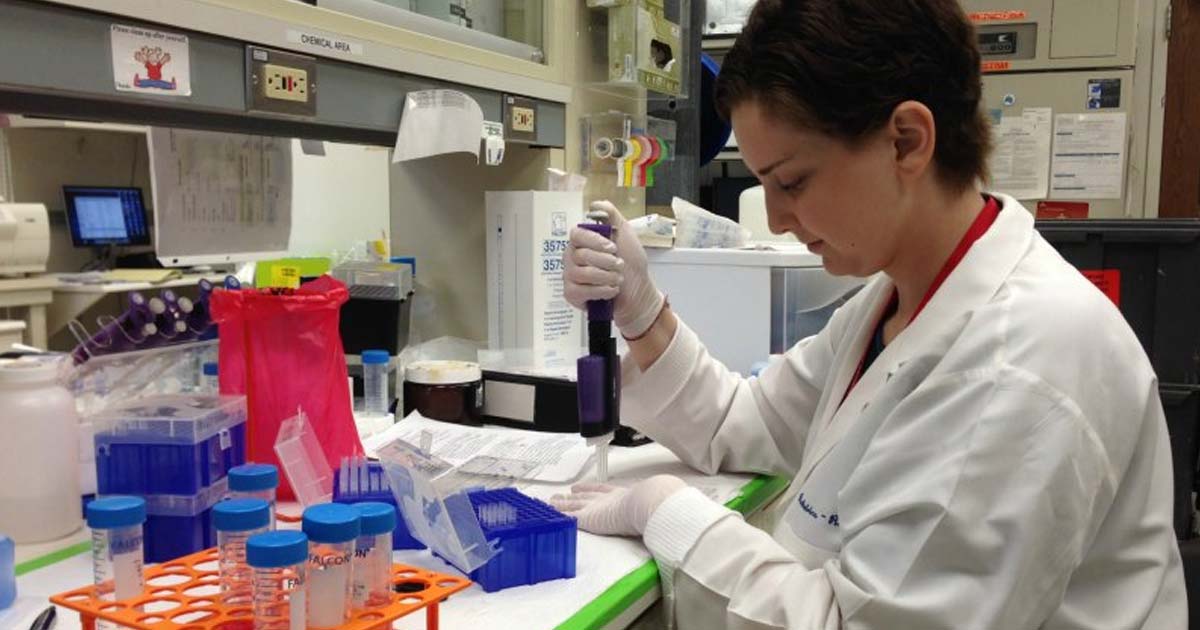Our St. Baldrick’s Foundation Research Outcomes blogs highlight examples of the progress your donations are supporting. This quarterly edition focuses on a potential treatment for glioblastoma, new treatment models for osteosarcoma, new immunotherapy for sarcomas, and a novel way to identify high-risk AML patients.
Thank you for making this research a reality.
Vaccine Hints at Potential Therapy Against Glioblastoma
Immunotherapy is a mainstay treatment for many cancers, however it has yet to break through as a treatment for brain cancer. But recent results from several small clinical trials have hinted at the possibility of reversing this trend. Among them are findings from a very small trial testing a cancer treatment vaccine developed by researchers at the University of Florida. Supported in part by a St. Baldrick’s Scholar award, Dr. Elias Sayour, reported that the vaccine was effective in pet dogs with naturally occurring brain cancers, allowing them to live much longer than would typically be expected. While they also reported positive initial findings from a trial involving people, he stressed that there’s still a long way to go before it’s known whether the vaccine is, in fact, safe and, as importantly, can help people live longer.
They hope to address these questions in additional small clinical trials of the vaccine already in the works, Dr. Sayour said, including one in children with brain cancers. This grant was supported by the St. Baldrick’s Foundation – Hannah’s Heroes Hero Fund.
New Models to Advance Osteosarcoma Treatments
St. Baldrick’s funded researcher, Dr. Betsy Young, and colleagues have been developing new models to better understand and treat osteosarcoma. By developing new models and cell lines, researchers can better understand the genetic and phenotypic diversity of osteosarcoma tumors. This leads to more accurate preclinical testing of new treatments and the identification of effective therapies tailored to individual patients’ tumor profiles. A recent study showed that their models can effectively mimic the disease seen in patients, making them valuable tools for testing new treatments. Specifically, this study highlighted the effectiveness of a drug called dinaciclib in reducing metastatic tumor growth, showcasing the potential of these models to aid in the development of targeted therapies for osteosarcoma. The next steps include validating and translating the promising findings from models into patients.
This grant was supported by Battle Osteosarcoma and the St. Baldrick’s Foundation – Team Jackson Hero Fund.
Innovative Treatment Targets Pediatric Sarcoma
A new study from Baylor College of Medicine, supported in part by the St. Baldrick’s Foundation EPICC Team award, describes promising results for a phase I trial of CAR T-cell therapy targeting the HER2 antigen in treating advanced pediatric sarcoma, including rhabdomyosarcoma and osteosarcoma. These types of sarcomas are aggressive and often challenging to treat in children. This innovative therapy modifies patients’ T cells to attack cancer cells. The results showed safety and reduced tumor size in some patients, with one patient remaining cancer-free for over five years.
This offers hope for more effective treatments and improved outcomes for pediatric sarcoma patients, especially those with limited treatment options. Further trials will explore combining this therapy with other treatments.
Identifying High-Risk AML Patients
In a recently published study, Dr. Jatinder Lamba and colleagues used data from 10 clinical trials involving over 3,500 acute myeloid leukemia (AML) patients to predict treatment outcomes. They developed two new genetic scoring systems and found that high scores on either system are associated with worse outcomes. By integrating these scores, patients can be categorized into four risk groups, providing a more precise prognosis and potentially guiding personalized treatment strategies. This approach especially enhances the ability to identify patients at higher risk and tailor their treatment plans accordingly.
This work was supported through a grant made in partnership with the American Cancer Society and St. Baldrick’s Foundation.
Not every publication of research supported by St. Baldrick’s makes the news, but each one adds to the body of scientific knowledge that takes us one step closer to better outcomes for kids with cancer. Your continued support will make more research possible to Conquer Kids’ Cancer.



